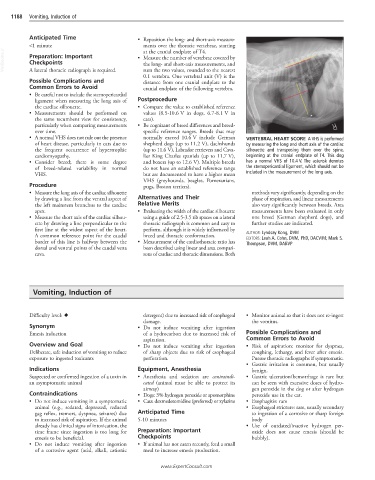Page 2403 - Cote clinical veterinary advisor dogs and cats 4th
P. 2403
1188 Vomiting, Induction of
Anticipated Time • Reposition the long- and short-axis measure-
<1 minute ments over the thoracic vertebrae, starting
VetBooks.ir Preparation: Important • Measure the number of vertebrae covered by
at the cranial endplate of T4.
Checkpoints
the long- and short-axis measurements, and
sum the two values, rounded to the nearest
A lateral thoracic radiograph is required.
0.1 vertebra. One vertebral unit (V) is the
Possible Complications and distance from one cranial endplate to the
Common Errors to Avoid cranial endplate of the following vertebra.
• Be careful not to include the sternopericardial
ligament when measuring the long axis of Postprocedure
the cardiac silhouette. • Compare the value to established reference
• Measurements should be performed on values (8.5-10.6 V in dogs, 6.7-8.1 V in
the same recumbent view for consistency, cats). *
particularly when comparing measurements • Be cognizant of breed differences and breed-
over time. specific reference ranges. Breeds that may
• A normal VHS does not rule out the presence normally exceed 10.6 V include German VERTEBRAL HEART SCORE A VHS is performed
of heart disease, particularly in cats due to shepherd dogs (up to 11.2 V), dachshunds by measuring the long and short axis of the cardiac
the frequent occurrence of hypertrophic (up to 11.6 V), Labrador retrievers and Cava- silhouette and transposing them over the spine,
cardiomyopathy. lier King Charles spaniels (up to 11.7 V), beginning at the cranial endplate of T4. This dog
• Consider breed; there is some degree and boxers (up to 12.6 V). Multiple breeds has a normal VHS of 10.4 V. The asterisk denotes
of breed-related variability in normal do not have an established reference range the sternopericardial ligament, which should not be
VHS. but are documented to have a higher mean included in the measurement of the long axis.
VHS (greyhounds, beagles, Pomeranians,
Procedure pugs, Boston terriers).
• Measure the long axis of the cardiac silhouette methods vary significantly, depending on the
by drawing a line from the ventral aspect of Alternatives and Their phase of respiration, and linear measurements
the left mainstem bronchus to the cardiac Relative Merits also vary significantly between breeds. Area
apex. • Evaluating the width of the cardiac silhouette measurements have been evaluated in only
• Measure the short axis of the cardiac silhou- using a guide of 2.5-3.5 rib spaces on a lateral one breed (German shepherd dogs), and
ette by drawing a line perpendicular to the thoracic radiograph is common and easy to further studies are indicated.
first line at the widest aspect of the heart. perform, although it is widely influenced by AUTHOR: Lyndsay Kong, DVM
A common reference point for the caudal breed and thoracic conformation. EDITORS: Leah A. Cohn, DVM, PhD, DACVIM; Mark S.
border of this line is halfway between the • Measurement of the cardiothoracic ratio has Thompson, DVM, DABVP
dorsal and ventral points of the caudal vena been described using linear and area compari-
cava. sons of cardiac and thoracic dimensions. Both
Vomiting, Induction of
Difficulty level: ♦ detergent) due to increased risk of esophageal • Monitor animal so that it does not re-ingest
damage. the vomitus.
Synonym • Do not induce vomiting after ingestion
Emesis induction of a hydrocarbon due to increased risk of Possible Complications and
aspiration. Common Errors to Avoid
Overview and Goal • Do not induce vomiting after ingestion • Risk of aspiration: monitor for dyspnea,
Deliberate, safe induction of vomiting to reduce of sharp objects due to risk of esophageal coughing, lethargy, and fever after emesis.
exposure to ingested toxicants perforation. Pursue thoracic radiographs if symptomatic.
• Gastric irritation is common, but usually
Indications Equipment, Anesthesia benign.
Suspected or confirmed ingestion of a toxin in • Anesthesia and sedation are contraindi- • Gastric ulceration/hemorrhage is rare but
an asymptomatic animal cated (animal must be able to protect its can be seen with excessive doses of hydro-
airway) gen peroxide in the dog or after hydrogen
Contraindications • Dogs: 3% hydrogen peroxide or apomorphine peroxide use in the cat.
• Do not induce vomiting in a symptomatic • Cats: dexmedetomidine (preferred) or xylazine • Esophagitis: rare
animal (e.g., sedated, depressed, reduced • Esophageal stricture: rare, usually secondary
gag reflex, tremors, dyspnea, seizures) due Anticipated Time to ingestion of a corrosive or sharp foreign
to increased risk of aspiration. If the animal 5-10 minutes body
already has clinical signs of intoxication, the • Use of outdated/inactive hydrogen per-
time frame since ingestion is too long for Preparation: Important oxide does not cause emesis (should be
emesis to be beneficial. Checkpoints bubbly).
• Do not induce vomiting after ingestion • If animal has not eaten recently, feed a small
of a corrosive agent (acid, alkali, cationic meal to increase emesis production.
www.ExpertConsult.com

